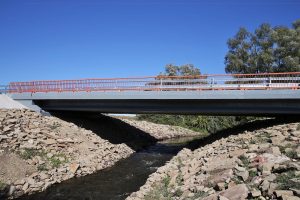 If you live on a rural property that requires crossing a water stream, large ditch or another concern with the level of the road or road conditions, then you might want to consider building a bridge to address these concerns.
If you live on a rural property that requires crossing a water stream, large ditch or another concern with the level of the road or road conditions, then you might want to consider building a bridge to address these concerns.
However, building a bridge is not all that simple. It requires proper planning, acquiring the necessary licenses and permits, and ensuring the bridge is strong and big enough to meet your needs and hold the weight it will need to hold. Otherwise, local government agencies may shut down the project or the bridge may run the risk of collapsing.
Stepts To Build A Bridge
People who prefer to save money and build their own bridge can effectively carry out the project, although doing so must be taken seriously and properly planned for. The following is an extensive guide on how to build a bridge yourself.
Consider The Regulations
There is sometimes a lot of red tape to get through whenever building a bridge, particularly if the bridge is being constructed over a water source. Without going through all of the red tape and getting the proper permits and licenses, your project might be forced to a halt in the middle of construction. Every location is different and the regulations may vary. However, several of the more common agencies and organizations to reach out to during the planning stages includes:
- Fish and Wildlife;
- Department of Forestry;
- Local Fire District; and
- FEMA.
 You can also check with the local government and the Homeowners Association for more regulations that you may need to consider as you plan to build your bridge. It is also important to consider the water level and the height of your bridge. Bridges need to be built above the 100-year high water mark if built over a water source.
You can also check with the local government and the Homeowners Association for more regulations that you may need to consider as you plan to build your bridge. It is also important to consider the water level and the height of your bridge. Bridges need to be built above the 100-year high water mark if built over a water source.
Once you have approval from all necessary government and private agencies, you should be able to proceed with your bridge planning. You will need to invest in high-quality materials. Otherwise, the bridge may develop issues with water and weather damage as the years go by.
Build A Strong Foundation
You can start your bridge construction project by determining the elevation of the support system for the top and bottom of the bridge. The bridge foundation should be at least one foot higher than the base flood elevation. A laser level might be necessary to determine the elevation level. Once you know your measurements, you can create the bridge footings. This is an important step as the footings are responsible for bearing a lot of weight. It likely requires professional assistance and the use of high-grade materials.
After the footing is created, the sub-base for the foundation should be built. I-beams that match the size bridge that you need to work well for this. You can then position the I-beams onto the footings. Depending on the size of your bridge, you may need the help of an excavator to properly position the I-beams.
Next, you can pour concrete over the bridge footings for extra strength. Once the foundation is established, you can use plywood to build the base of the foundation. It may require some work to ensure the plywood skins are properly positioned inside the sub-base.
Build A Strong Frame
 Now that the foundation is established, it is time to build the bridge frame. To start, you will need to secure stringers across the bridge. Be sure to get the measurements and cut the stringers accordingly. For larger bridges, multiple stringers are likely required in a row. You can secure the stringers with large bolts.
Now that the foundation is established, it is time to build the bridge frame. To start, you will need to secure stringers across the bridge. Be sure to get the measurements and cut the stringers accordingly. For larger bridges, multiple stringers are likely required in a row. You can secure the stringers with large bolts.
You will then need to connect five evenly-spaced deck boards across the stringers on the bridge. It is helpful to predrill the deck boards to ensure you know where the bolts go and allow them to go in more easily. The deck boards should securely connect into the beam stringers.
You can then fill in the rest of the bridge with deck boards to complete the frame. At this point, the base of your bridge should be complete, and the finish line should be in sight.
Backfill The Bridge
The next and last step in the bridge-building process is to backfill the bridge. Be sure to use quality material that is safe to drive on to connect where the bridge is to the road. For rural areas on your property, high-quality gravel may work. Be sure to check with local government agencies during the planning stages as to what the best backfill material is. You can also consult with and hire a professional company for asphalt paving to finish your bridge construction.
After you lay the backfill and level it, you should be good to test out your bridge. It should be able to hold the weight of large trucks reliably and withstand pressure for years. Your bridge should also be high enough over water (if applicable) to withstand any flood that may occur.
The building process is complete at this point, and you should be protected from any concerns of the local government as long as you went through the proper steps during the planning stages. Now you can enjoy your new bridge.
Talk To The Professionals At Dirt Connections To Learn More
 Building a bridge is not an easy task for professionals, let alone DIYers. However, it is possible for ambitious homeowners to build a bridge by following the process laid out in this article. To ensure your bridge is strong, it is best to make sure you have high-quality equipment and building supplies.
Building a bridge is not an easy task for professionals, let alone DIYers. However, it is possible for ambitious homeowners to build a bridge by following the process laid out in this article. To ensure your bridge is strong, it is best to make sure you have high-quality equipment and building supplies.
To learn more about what all is needed to build a bridge on your own, get in touch with our team at Dirt Connections today. We can help you and answer any questions you may have. We also have an extensive inventory of filling materials to help you with the backfill for your bridge. We have years of experience in the industry, and we understand the importance of completing projects such as building a bridge right the first time.
Summary

Dirt Connections was started with one goal in mind: providing quality residential and commercial construction services to clients on time and on budget. Reach out for more information on how we can support your next project.
For your convenience our estimates are free and by appointment. Call 703-940-9949 for a free estimate today!









































